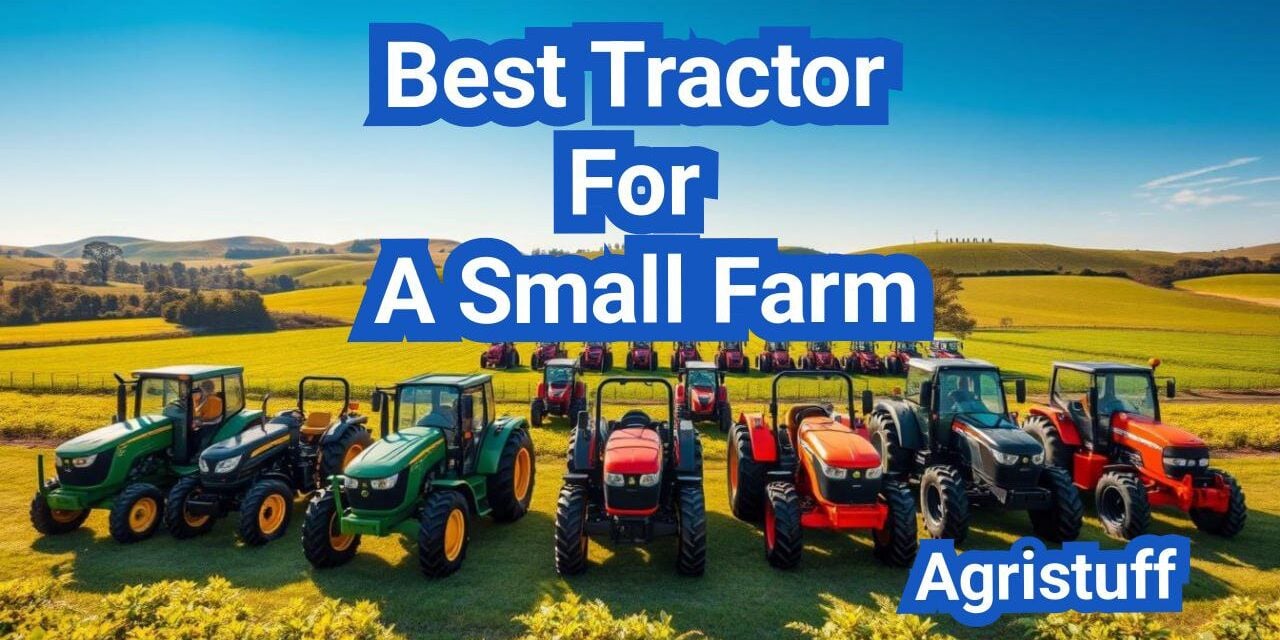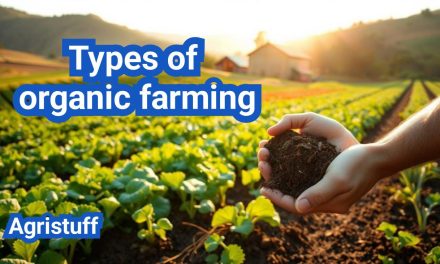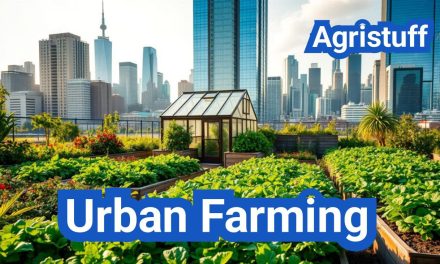Starting a small farm or homestead is an exciting venture, but it comes with its challenges. One of the biggest hurdles is finding the right equipment to handle tasks from soil preparation to hauling feed.
The right farm tractor can make all the difference in the efficiency and productivity of your farm. When selecting a tractor, factors such as horsepower, maneuverability, and attachments should be considered to ensure it meets your specific needs.
For small acreage, a reliable and versatile tractor is crucial. It should be appropriately sized for the workload, making farm operations smoother and more manageable.
Key Takeaways
- Choosing Best Tractor for a Small Farm operations.
- Consider horsepower, maneuverability, and attachments when selecting a tractor.
- A reliable and versatile tractor is essential for small acreage.
- The right tractor improves farm efficiency and productivity.
- Assess your specific needs before making a purchase.
Understanding Small Farm Tractor Needs
Understanding the unique demands of small-scale farming is essential for choosing the best tractor. Whether you’re managing a few acres for hobby farming or planning to expand into a full-scale farmstead, the best utility tractor for your small farm will be reliable, versatile, and sized to match your acreage and workload.
Defining “Small Farm” in the American Context | Best Tractor for a Small Farm
In the United States, the definition of a “small farm” can vary significantly. Generally, it refers to agricultural operations that earn less than $250,000 annually. These farms can range from a few acres to several hundred acres, with diverse farming activities such as livestock raising, crop production, or a mix of both.
Small farms play a crucial role in local food systems, contributing to the economy and environmental sustainability. The size and type of tractor needed can vary greatly depending on the farm’s specific characteristics.
Matching Tractor Size to Acreage | Best Tractor for a Small Farm
The size of the tractor required is directly related to the acreage of the farm. For smaller plots (under 10 acres), a sub-compact tractor might suffice, offering maneuverability and efficiency for tasks like mowing, tilling, and hauling light loads.
For larger small farms (10-50 acres), a compact tractor is often more appropriate, providing the necessary power for heavier tasks while still being versatile and relatively fuel-efficient.
Common Tasks and Required Capabilities | Best Tractor for a Small Farm
Small farms perform a variety of tasks that require different capabilities from their tractors. Common tasks include:
- Land preparation (tilling, harrowing)
- Mowing and brush control
- Hauling and transporting materials
- Livestock care (fencing, feeding)
- The tractor must be capable of handling these tasks efficiently, with the appropriate power, attachments, and implements. Understanding these needs is crucial for selecting a tractor that matches the farm’s workload and operational requirements.
Compact vs. Sub-Compact Tractors for Small Farms

Compact and sub-compact tractors are both viable options for small farms, but they cater to different needs and scales of operation. Understanding the differences between these two types of tractors is essential for making an informed decision that aligns with the specific requirements of your farm.
Size and Power Differences | Best Tractor for a Small Farm
The primary distinction between compact and sub-compact tractors lies in their size and power output. Sub-compact tractors typically have less than 25 horsepower, making them suitable for very small farms or gardens with limited tasks. Compact tractors, on the other hand, range from 25 to 50 horsepower, offering more versatility and capability for a wider range of tasks.
Size Comparison: Sub-compact tractors are generally smaller and more maneuverable, ideal for tight spaces and smaller acreages. Compact tractors, while still relatively compact, are larger and more powerful, capable of handling more demanding tasks.
Capability Comparison | Best Tractor for a Small Farm
The capability of a tractor is directly related to its power and size. Compact tractors can handle more complex tasks such as plowing, tilling, and hauling heavier loads, thanks to their higher power output. Sub-compact tractors are better suited for lighter tasks like mowing, small-scale tilling, and hauling lighter loads.
| Tractor Type | Power Range (HP) | Suitable Tasks |
|---|---|---|
| Sub-Compact | Under 25 | Mowing, small-scale tilling, light hauling |
| Compact | 25-50 | Plowing, tilling, heavier hauling, loader work |
When to Choose Each Type | Best Tractor for a Small Farm
The choice between a compact and sub-compact tractor depends on the specific needs of your farm. If your operation involves lighter tasks and you have a smaller acreage, a sub-compact tractor might be the most cost-effective and efficient choice. However, if you anticipate needing to perform more demanding tasks or work on a larger scale, a compact tractor would be more appropriate.
In conclusion, understanding the differences between compact and sub-compact tractors is crucial for selecting the right equipment for your small farm. By considering factors like size, power, and capability, you can make an informed decision that enhances your farm’s productivity and efficiency.
Essential Tractor Features for Small Farm Operations
Essential features in a small farm tractor can make a substantial difference in its utility and the overall success of the farm. When choosing a tractor, farmers must consider several critical aspects to ensure they select a machine that meets their specific needs.
PTO Horsepower Requirements | Best Tractor for a Small Farm
The Power Take-Off (PTO) horsepower is a crucial factor in determining a tractor’s capability to handle various implements. PTO horsepower for small farm implements typically ranges from 15 to 40 HP, depending on the type and size of the equipment being used.
For instance, smaller implements like rotary cutters or seeders may require less PTO horsepower, while larger equipment such as balers or hay rakes demand more power. It’s essential to match the tractor’s PTO horsepower to the implements you plan to use.
| Implement | PTO Horsepower Required |
|---|---|
| Rotary Cutter | 15-25 HP |
| Seeder/Drill | 20-30 HP |
| Hay Baler | 30-40 HP |
Hitch Systems Explained (Category 1) | Best Tractor for a Small Farm
A Category 1 hitch is standard on most small farm tractors. This hitch system is designed for smaller implements and provides a secure connection between the tractor and the equipment.
The Category 1 hitch is suitable for a wide range of implements, including plows, cultivators, and mowers. Its versatility and compatibility make it an essential feature for small farm tractors.
Transmission Options: Hydrostatic vs. Shuttle Shift | Best Tractor for a Small Farm
Transmission type is another vital consideration. Hydrostatic transmissions offer smooth, infinitely variable speed control, making them ideal for tasks that require precise speed adjustments, such as loader work or mowing.
Shuttle shift transmissions, on the other hand, provide quick direction changes and are often preferred for tasks that involve frequent reversing, such as loading or backing up to a trailer.
- Hydrostatic: Smooth, variable speed control; ideal for loader work and mowing.
- Shuttle Shift: Quick direction changes; suitable for tasks involving frequent reversing.
Loader and Backhoe Attachments | Best Tractor for a Small Farm
Loader and backhoe attachments significantly enhance a tractor’s versatility. A front-end loader is invaluable for tasks like moving heavy materials, digging, and loading, while a backhoe attachment provides the capability for digging trenches and performing other excavation tasks.
When selecting a tractor, consider whether these attachments are available for your chosen model and factor their cost into your overall budget.
Best Tractor for Small Farm: Top Models by Size

When it comes to selecting the best tractor for a small farm, understanding the different sizes and capabilities is crucial. The size of the tractor needed depends largely on the acreage of the farm and the specific tasks to be performed.
Small farms typically require tractors that are versatile, efficient, and powerful enough to handle various tasks. The market offers a range of tractors categorized by their size: sub-compact, compact, and mid-size.
Sub-Compact Champions (Under 25 HP) | Best Tractor for a Small Farm
Sub-compact tractors are ideal for very small farms or homesteads with under 10 acres. They are perfect for light-duty tasks such as mowing, tilling small gardens, and hauling small loads.
- Kubota BX1880: Known for its reliability and versatility, this tractor offers 18.5 HP and is suitable for small-scale farming tasks.
- John Deere 1023E: With 25 HP, this tractor is compact yet powerful, making it ideal for small farms with limited space.
Compact Powerhouses (25-50 HP) | Best Tractor for a Small Farm
Compact tractors are suitable for farms between 10 to 50 acres. They offer more power and can handle a variety of tasks including plowing, tilling, and loader work.
- Kubota L6060: This 60 HP tractor is a robust option for small farms needing more power for heavy-duty tasks.
- Mahindra eMax 25S: With 24.4 HP, this tractor is a compact powerhouse suitable for small farms requiring versatility.
Mid-Size Options (50-75 HP) | Best Tractor for a Small Farm
Mid-size tractors are ideal for larger small farms or those needing more power for demanding tasks. They can efficiently handle larger implements and more extensive acreage.
- New Holland Workmaster 50: Offering 50 HP, this tractor is designed for heavy-duty work on small farms.
- Case IH Farmall JX75: With 74 HP, this tractor provides the power needed for larger small farm operations.
By understanding the different sizes and capabilities of tractors, small farm owners can make informed decisions that best suit their operational needs.
Budget-Friendly Tractor Options for Small Farms
Small farms require tractors that are not only efficient but also budget-friendly. The challenge lies in finding the right balance between cost and capability. Whether you’re a seasoned farmer or just starting out, there are several options to consider that can help keep your initial investment low without compromising on performance.
Best Value New Tractors Under $20,000 | Best Tractor for a Small Farm
For many small farmers, the ideal tractor is one that offers a robust set of features at an affordable price. The Kubota BX23S is a highly rated sub-compact tractor that fits this bill, offering excellent value with features like a front-loader implement disconnect and swift-connect backhoe. When looking for new tractors under $20,000, consider models that provide a good balance between power and fuel efficiency.
Some key features to look for in budget-friendly new tractors include:
- Sufficient PTO horsepower for your implements
- A reliable transmission system, such as hydrostatic or shuttle shift
- Optional loader and backhoe attachments for versatility
Quality Used Tractor Considerations | Best Tractor for a Small Farm
Buying a used tractor can be a cost-effective way to acquire the equipment you need. However, it’s crucial to inspect the tractor thoroughly to ensure it’s in good working condition. Consider the following when evaluating used tractors:
- Check the tractor’s maintenance history and records
- Inspect for signs of wear on critical components like tires, hydraulic systems, and engine
- Test the tractor to ensure all functions are operating as expected
Used tractors can often be found through local dealerships, online marketplaces, or auctions. Be sure to compare prices and consider getting a mechanic’s inspection if possible.
Financing Options for Small Farm Tractors in the USA | Best Tractor for a Small Farm
Financing a tractor purchase can make it more manageable by spreading the cost over time. Several financing options are available for small farm tractors, including:
- Dealer financing: Many tractor dealerships offer financing options directly to customers.
- Bank and credit union loans: Traditional lenders often have loan programs for farm equipment.
- Specialized agricultural lenders: Some lenders specialize in agricultural financing, offering competitive rates and terms tailored to farming operations.
When exploring financing options, be sure to compare interest rates, repayment terms, and any associated fees to find the best fit for your farm’s financial situation.
Top Tractor Brands for Small Farm Applications

The small farm tractor market is dominated by several top brands known for their reliability and performance. These brands offer a range of models that cater to different needs and budgets, making it easier for small farm owners to find the perfect tractor.
John Deere Small Farm Models | Best Tractor for a Small Farm
John Deere is a well-respected name in the agricultural industry, and their tractors are popular among small farm owners. The John Deere 3038E is a compact tractor that offers 38 horsepower and a user-friendly design. It’s ideal for tasks such as mowing, tilling, and hauling.
Another model, the John Deere 5065E, provides 65 horsepower and is suitable for more demanding tasks. It features a powerful engine and a range of transmission options, making it versatile for various farm operations.
Kubota’s Small Farm Lineup | Best Tractor for a Small Farm
Kubota is another leading brand that offers a variety of tractors suitable for small farms. The Kubota L6060 is a compact tractor with 60 horsepower, known for its durability and ease of use. It’s designed for tasks such as loader work, mowing, and plowing.
Kubota also offers the L6060DTHB, which comes with a front loader and backhoe, making it a versatile option for farms that require both capabilities.
New Holland, Mahindra, and Other Contenders | Best Tractor for a Small Farm
New Holland and Mahindra are also significant players in the small farm tractor market. New Holland’s Workmaster 25S is a compact tractor that provides 25 horsepower and is designed for small-scale farming and landscaping tasks.
Mahindra offers a range of tractors, including the Mahindra 2538, which is known for its affordability and reliability. It’s suitable for small farms and offers a range of implements and attachments.
Other brands, such as Case IH and Massey Ferguson, also offer competitive models. The key is to compare features, pricing, and after-sales support to determine the best fit for your specific needs.
| Brand | Model | Horsepower | Key Features |
|---|---|---|---|
| John Deere | 3038E | 38 | Compact design, user-friendly |
| Kubota | L6060 | 60 | Durable, versatile, loader capabilities |
| New Holland | Workmaster 25S | 25 | Compact, suitable for small-scale farming |
| Mahindra | 2538 | 38 | Affordable, reliable, range of implements |
As noted by agricultural expert,
“The right tractor can significantly improve the efficiency of small farm operations. Brands like John Deere and Kubota are often preferred for their reliability and performance.”
Specialized Tractors for Different Small Farm Types

Small farms vary widely in their operations, from livestock and market gardens to hay production and horse farms, each requiring specialized tractors. The type of tractor needed can vary significantly depending on the farm’s specific use.
Best Tractors for Livestock Operations | Best Tractor for a Small Farm
Livestock operations require tractors that can handle tasks such as feeding, manure management, and pasture maintenance. Tractors with loader attachments are particularly useful for these tasks.
For example, a tractor like the John Deere 3038E is well-suited for small livestock operations due to its compact size and versatility.
Ideal Tractors for Market Gardens | Best Tractor for a Small Farm
Market gardens need tractors that can navigate tight spaces and perform tasks like tilling, planting, and harvesting. Narrow-profile tractors are ideal for these operations.
The Kubota BX2380 is a good example, offering a compact design and the ability to be equipped with various implements for different tasks.
Tractors for Hay and Forage Production | Best Tractor for a Small Farm
For hay and forage production, tractors need to be capable of handling heavy implements like mowers and balers. Higher horsepower tractors with robust transmission systems are necessary.
The New Holland Workmaster 25S is suitable for small-scale hay and forage production, providing the necessary power and durability.
Best Options for Small Horse Farms | Best Tractor for a Small Farm
Small horse farms require tractors for tasks such as mowing, fencing, and manure management. Tractors with three-point hitch systems and PTO capabilities are particularly useful.
The Mahindra eMax 20S is a good choice, offering the versatility needed for various tasks around a small horse farm.
When selecting a tractor for your small farm, it’s essential to consider the specific tasks you’ll be performing and choose a tractor that meets those needs.
| Farm Type | Ideal Tractor Features | Example Tractors |
|---|---|---|
| Livestock Operations | Loader attachments, compact size | John Deere 3038E |
| Market Gardens | Narrow profile, versatility | Kubota BX2380 |
| Hay and Forage Production | Higher horsepower, robust transmission | New Holland Workmaster 25S |
| Small Horse Farms | Three-point hitch, PTO capabilities | Mahindra eMax 20S |
Essential Implements and Attachments for Small Farm Tractors

The versatility of a small farm tractor is greatly enhanced by the right implements and attachments. These tools not only expand the range of tasks your tractor can perform but also increase its efficiency and productivity.
Must-Have Implements for General Farm Work | Best Tractor for a Small Farm
For general farm work, certain implements are considered essential. These include:
- Loader: Ideal for moving heavy materials like soil, sand, and manure.
- Backhoe: Useful for digging trenches, holes, and for other excavation tasks.
- Tiller: Essential for preparing soil for planting by breaking up clods and aerating the soil.
- Box Blade: Great for grading and leveling land, as well as for maintaining driveways and paths.
These implements can significantly enhance your tractor’s capability to handle various farm tasks.
5-Foot Rotary Cutter Requirements | Best Tractor for a Small Farm
A 5-foot rotary cutter is a valuable implement for small farms, particularly for managing brush and small trees. When selecting a rotary cutter, consider the following:
- PTO Horsepower: Ensure your tractor’s PTO horsepower is sufficient to handle the cutter. Typically, a 5-foot rotary cutter requires at least 25-30 PTO horsepower.
- Deck Thickness: A thicker deck can withstand heavier use and last longer.
- Blade Quality: High-quality blades will cut more efficiently and require less maintenance.
Matching Implements to Your Tractor’s Capabilities | Best Tractor for a Small Farm
It’s crucial to match the implements to your tractor’s capabilities to ensure efficient operation and to prevent damage to both the tractor and the implement. Consider the following factors:
- PTO Horsepower: As mentioned, ensure your tractor’s PTO horsepower can handle the implement.
- Hydraulic Flow: Some implements, like loaders, require sufficient hydraulic flow to operate effectively.
- Lifting Capacity: Ensure your tractor’s three-point hitch can lift the implement.
By carefully selecting and matching implements to your tractor’s capabilities, you can maximize the utility and efficiency of your small farm operations.
Tractor Safety Features for Small Farm Operations

Small farm owners must prioritize tractor safety to prevent accidents and ensure a secure working environment. Tractors are indispensable for farm operations, but they can also be hazardous if not equipped with proper safety features.
ROPS and Seatbelt Systems | Best Tractor for a Small Farm
One of the most critical safety features for tractors is the Roll-Over Protective Structure (ROPS) along with a seatbelt system. ROPS is designed to protect the operator in the event of a rollover, while the seatbelt ensures that the operator remains within the protective zone.
Key benefits of ROPS and seatbelt systems include:
- Reduced risk of injury or fatality during rollover accidents
- Enhanced operator safety during challenging farm tasks
- Compliance with safety regulations and standards
Operator Comfort and Fatigue Reduction | Best Tractor for a Small Farm
Operator comfort is closely linked to safety, as fatigue can significantly impair an operator’s ability to safely maneuver a tractor. Features that enhance comfort and reduce fatigue include:
- Ergonomic seating and controls
- Effective suspension systems
- Climate-controlled cabs
| Comfort Feature | Benefit |
|---|---|
| Ergonomic Seating | Reduces operator fatigue during long hours of operation |
| Climate-Controlled Cab | Enhances operator comfort in extreme weather conditions |
Child and Family Safety Considerations | Best Tractor for a Small Farm
Small farms often involve family members, including children, in various capacities. It’s crucial to consider their safety around tractors. Some key considerations include:
- Ensuring that children are kept at a safe distance from operating tractors
- Implementing safety training for all family members who operate tractors
- Using safety features like rollover protection and secure storage for tractor keys
By prioritizing tractor safety features and practices, small farm owners can significantly reduce the risk of accidents and create a safer working environment for everyone involved.
Buying Guide: How to Select the Right Small Farm Tractor

When it comes to choosing a tractor for your small farm, several factors need to be considered to ensure you make the right investment. The decision-making process involves evaluating your farm’s specific needs, understanding the differences between new and used tractors, and knowing where to purchase your equipment.
New vs. Used Decision Framework | Best Tractor for a Small Farm
One of the primary decisions you’ll need to make when buying a tractor is whether to purchase a new or used model. New tractors offer the latest technology, better fuel efficiency, and a manufacturer’s warranty, which can provide peace of mind and potentially lower maintenance costs in the short term. On the other hand, used tractors can be significantly more budget-friendly upfront, but may require more maintenance and repairs.
To make this decision, consider the following factors:
- The size and complexity of your farm operations
- Your budget for the tractor purchase and ongoing maintenance
- The availability of financing options and their associated costs
- The potential for technological advancements in new tractors to improve your efficiency
Dealer vs. Private Party Purchases | Best Tractor for a Small Farm
Another critical decision is whether to buy from a dealership or a private party. Purchasing from a reputable dealer often provides additional benefits such as warranties, service support, and potentially certified pre-owned programs for used tractors. In contrast, buying from a private party may offer a lower purchase price, but it also means you’ll likely forgo these additional protections and support.
Consider the following when deciding between a dealer and a private party:
“When buying from a private seller, ensure you inspect the tractor thoroughly and consider having a mechanic inspect it as well to avoid potential pitfalls.”
Used Compact Tractor Buying Checklist | Best Tractor for a Small Farm
If you decide to purchase a used tractor, having a comprehensive checklist is crucial. Here are key items to include:
- Review maintenance records and history
- Inspect for signs of wear or needed repairs
- Test the tractor’s functionality, including PTO and hydraulics
- Check for any signs of tampering or odometer rollback
Warranty and Service Plan Considerations | Best Tractor for a Small Farm
Understanding the warranty and service plan options available is vital, especially for new tractors or certified pre-owned models. A comprehensive warranty can protect your investment against unexpected repair costs. Additionally, a service plan can help maintain your tractor’s performance and longevity.
When evaluating warranty and service plans, consider:
- The length of the warranty and what it covers
- The cost and coverage of extended service plans
- The availability and cost of parts and service
By carefully considering these factors and doing your research, you can make an informed decision that best suits your small farm’s needs.
Maintenance Considerations for Small Farm Tractors
Maintaining your small farm tractor is vital for its longevity and performance. Regular maintenance not only ensures the tractor remains operational but also enhances its efficiency and reduces the likelihood of costly repairs down the line.
Routine Maintenance Requirements | Best Tractor for a Small Farm
Routine maintenance is the backbone of tractor care. It involves regular checks and tasks such as oil changes, filter replacements, and lubrication of moving parts. Daily inspections before use can help identify potential issues early, preventing minor problems from becoming major repairs.
- Check engine oil and coolant levels
- Inspect tire pressure and condition
- Lubricate joints and moving parts
- Ensure all lights and signals are functioning
As John Deere, a leading tractor manufacturer, suggests, “Regular maintenance is key to getting the most out of your tractor.” This advice underscores the importance of sticking to a maintenance schedule.
Seasonal Service Needs | Best Tractor for a Small Farm
Seasonal servicing is crucial for preparing your tractor for the demands of different farming seasons. This may include tasks such as changing to seasonal tires, checking the condition of belts and hoses, and ensuring that all hydraulic systems are functioning properly.
“Seasonal maintenance is not just about preventing breakdowns; it’s about optimizing your tractor’s performance for the tasks ahead.” –
Mahindra Tractor Service Guide
| Season | Service Needs |
|---|---|
| Spring | Check hydraulic fluid, inspect mower blades |
| Summer | Monitor coolant levels, clean air filters |
| Fall | Prepare for winter by checking antifreeze, storing properly |
DIY vs. Professional Maintenance | Best Tractor for a Small Farm
Deciding between DIY and professional maintenance depends on the task’s complexity and your comfort level with tractor mechanics. Simple tasks like oil changes can be DIY, while complex repairs are best left to professionals.
DIY maintenance can save money and provide a sense of accomplishment, but it requires the right tools and knowledge. On the other hand, professional maintenance ensures that work is done correctly and can provide a warranty on repairs.
Parts Availability and Long-Term Support | Best Tractor for a Small Farm
Ensuring that parts are available for your tractor model is crucial for long-term support. Manufacturers like Kubota and New Holland typically offer good parts availability and support for their models.
When selecting a tractor, consider the manufacturer’s reputation for parts availability and customer support. This can significantly impact the long-term cost and hassle of maintaining your tractor.
Real-World Small Farm Tractor Case Studies

Real-world case studies provide valuable insights into tractor usage on small farms, helping farmers make informed decisions about their equipment needs.
By examining specific examples of tractor usage on farms of varying sizes, we can better understand the challenges and opportunities faced by small farm owners. Let’s explore three case studies that demonstrate effective tractor solutions for different acreages and farm types.
5-Acre Homestead Tractor Solution | Best Tractor for a Small Farm
For a 5-acre homestead, a compact tractor with versatile capabilities is often the best choice. One farmer used a Kubota BX1880 to manage their property, leveraging its loader and backhoe attachments for tasks such as clearing land, moving materials, and digging irrigation ditches.
The tractor’s compact size allowed for easy maneuverability in tight spaces, while its 18 HP engine provided sufficient power for most tasks. Key features included a hydrostatic transmission for smooth operation and a Category 1 hitch for compatibility with various implements.
20-Acre Mixed-Use Farm Equipment | Best Tractor for a Small Farm
A 20-acre mixed-use farm requires a tractor that can handle a variety of tasks, from tilling and planting to hauling and loading. One successful example is the use of a John Deere 3032E, which offered the necessary power and versatility.
This tractor featured a 32 HP engine, a loader for moving materials, and a rear PTO for powering implements like rotary cutters and tillers. The farmer appreciated the tractor’s ability to handle demanding tasks while remaining fuel-efficient.
40-Acre Commercial Small Farm Setup | Best Tractor for a Small Farm
For a 40-acre commercial small farm, a more powerful tractor is typically required to manage the increased workload. A Mahindra 4540 was used effectively on one such farm, providing the necessary power and capabilities.
Key features of this tractor included a 45 HP engine, a hydrostatic transmission for smooth operation, and a Category 1 hitch for implement compatibility. The farmer valued the tractor’s reliability and the manufacturer’s support network.
| Farm Size | Tractor Model | Key Features | Primary Uses |
|---|---|---|---|
| 5 Acres | Kubota BX1880 | 18 HP, Loader, Backhoe | Land clearing, Material moving, Ditch digging |
| 20 Acres | John Deere 3032E | 32 HP, Loader, Rear PTO | Tilling, Planting, Hauling, Loading |
| 40 Acres | Mahindra 4540 | 45 HP, Hydrostatic Transmission, Category 1 Hitch | Heavy tilling, Crop management, Material handling |
These case studies demonstrate that selecting the right tractor involves considering factors such as farm size, primary tasks, and required capabilities. By choosing a tractor that matches their specific needs, small farm owners can improve efficiency, reduce costs, and enhance their overall operations.
Making the Right Tractor Investment for Your Small Farm
Choosing the right tractor is a significant investment for small farms, requiring careful consideration of various factors to ensure the selected tractor meets the farm’s needs. By understanding the specific requirements of your small farm, you can make an informed decision that supports your farm’s success.
The best tractor for a small farm depends on several key factors, including acreage, budget, and the type of tasks the tractor will be used for. Whether you’re managing a small homestead or a larger agricultural operation, selecting the right tractor can greatly impact your productivity and efficiency.
By considering the factors outlined in this article, farmers can make a wise tractor investment that aligns with their specific needs and budget. This careful planning ensures that the tractor will be a valuable asset to the farm, supporting its long-term success and profitability.
FAQ
What is considered a small farm?
A small farm is typically defined as an agricultural operation that is smaller in scale, often with limited acreage, and may focus on niche or specialty crops. In the United States, the USDA defines a small farm as one that earns less than $250,000 in annual gross receipts.
What is a compact tractor?
A compact tractor is a smaller, more versatile tractor designed for small farms, homesteads, and landscaping tasks. They typically range from 20 to 50 horsepower and are ideal for tasks such as mowing, tilling, and hauling.
What are the key features to look for in a compact tractor for small farm use?
When selecting a compact tractor for small farm use, consider factors such as horsepower, transmission type, hitch system, loader and backhoe attachments, and operator comfort. PTO horsepower requirements, category 1 hitch compatibility, and hydrostatic or shuttle shift transmissions are also important.
How do I determine the right tractor size for my small farm?
To determine the right tractor size for your small farm, consider the acreage, terrain, and tasks you need to perform. A general rule of thumb is to choose a tractor with 1-2 horsepower per acre. For example, a 20-acre farm might require a 20-40 horsepower tractor.
What is the difference between hydrostatic and shuttle shift transmissions?
Hydrostatic transmissions use hydraulic fluid to transmit power, providing smooth, infinitely variable speed control. Shuttle shift transmissions, on the other hand, use a mechanical gear system with a hydraulic clutch, allowing for quick direction changes. Hydrostatic transmissions are often preferred for their ease of use and precision control.
What are the benefits of a loader and backhoe attachment for my small farm tractor?
Loader and backhoe attachments can greatly enhance the versatility of your compact tractor. A loader allows for efficient material handling, while a backhoe enables digging and excavation tasks. These attachments can be essential for tasks such as land preparation, maintenance, and construction.
How do I finance a tractor for my small farm?
Financing options for small farm tractors are available through various lenders, including equipment manufacturers, banks, and specialized agricultural financing companies. Consider factors such as interest rates, repayment terms, and down payment requirements when selecting a financing option.
What are the top tractor brands for small farm applications?
Top tractor brands for small farm applications include John Deere, Kubota, New Holland, Mahindra, and Kioti. These manufacturers offer a range of compact and sub-compact tractors with various features and capabilities.
How do I maintain my small farm tractor to ensure optimal performance?
Regular maintenance is crucial to extend the life of your small farm tractor. Perform routine tasks such as oil changes, tire pressure checks, and filter replacements. Additionally, consider seasonal service needs, such as winterization and pre-season checks, to ensure your tractor is ready for the demands of the farming season.
What safety features should I look for in a small farm tractor?
When selecting a small farm tractor, consider safety features such as ROPS (Roll-Over Protective Structure) and seatbelt systems. Operator comfort and fatigue reduction features, such as adjustable seating and ergonomic controls, are also important. Additionally, consider child and family safety considerations, such as ensuring that children are kept away from the tractor while it is in operation.
Conclusion of: Best Tractor for a Small Farm
Why this guide matters
If you’re hunting for the best tractor for small farm ownership, start with the actual jobs you’ll do and the acres you manage, not brand loyalty or paint color; the right match balances PTO horsepower, tractor weight, hydraulics, and dealer backup so you can mow, move, grade, till, and snowblow productively without overspending—this guide translates small-farm work into clear specs so you can confidently choose the best tractor for small farm needs today and five years from now. Penn State Extension – Managing Machinery & Equipment
How to use this guide (and the quick answer)
To zero-in on the best tractor for small farm situations fast, skim the acreage-based “Top Picks” below—1–5, 5–15, 15–30, and 30–50 acres—then sanity-check PTO horsepower against your implement list; if you only read one section, use those picks to create a short list and demo locally, because on-the-ground dealer support and fit will ultimately decide the best tractor for small farm value for you. UW–Madison Extension – Tractor pre-purchase considerations
Quick sizing by acreage
A practical rule for the best tractor for small farm sizing is: sub-compact (<25 hp) for 1–5 acres, compact (25–40 hp) for 5–15 acres, larger compact (35–55 hp) for 15–30 acres, and small utility (55–75 hp) for 30–50 acres; these bands aren’t rigid, but they’ll keep you in the right neighborhood while comparing candidates for the best tractor for small farm setup and budget. Bobcat – Guide to compact tractor sizes
Start with jobs and implements
The best tractor for small farm ownership is driven by your implements: brush cutter, rotary tiller, box blade, post-hole auger, snowblower, pallet forks, or baler; list the tools you’ll run, note hitch category and PTO horsepower needs, and size the tractor to the heaviest implement so the best tractor for small farm choice isn’t under-spec’d the day it arrives. NC State Extension – Selecting & Buying a Tractor
Understand PTO vs. engine horsepower
Brochures shout engine horsepower, but implements run on PTO horsepower; to choose the best tractor for small farm rig, prioritize the PTO number for mowers and tillers, and use independent test data to compare models apples-to-apples so your best tractor for small farm pick actually delivers power to the implement shaft. Virginia Tech Extension – Using Tractor Test Data
Weight, hydraulics, and loader capacity
Weight adds traction and stability while hydraulic flow and pressure determine loader speed and lift; if your short list for the best tractor for small farm can’t lift your typical loads or cycle the loader briskly, you’ll feel it every workday, so check spec sheets for pump flow, 3-pt lift, and loader ratings before calling it the best tractor for small farm. John Deere 1025R – Specs & features
Transmission choices (HST vs. gear/shuttle)
For loader work and tight spaces, hydrostatic (HST) transmissions often feel like the best tractor for small farm choice thanks to clutch-free forward/reverse; for steady PTO jobs like tilling or heavy mowing, a gear or power shuttle can be efficient—try both to decide which transmission makes the best tractor for small farm workflow for you. Bobcat – HST vs. Manual Transmissions
PTO and hitch basics you must confirm
Most small-farm implements expect a 540-rpm PTO and Category-1 hitch (sub-compacts may be Cat-1 Limited); confirming PTO type (live vs. independent) and the hitch category prevents painful mismatches and keeps your best tractor for small farm purchase plug-and-play with your current and future implements, protecting the best tractor for small farm investment. Hutson – 3-Point Hitch Categories Explained
Emissions and Tier 4—what it means for you
Modern compact tractors meet EPA Tier 4 Final emissions, cutting particulates and NOx dramatically versus older machines; that means the best tractor for small farm choice today will be cleaner, quieter, and more efficient, though you should learn the basics of regeneration and after-treatment to keep your best tractor for small farm running trouble-free. EPA – Nonroad Diesel Engine Regulations
Top picks: 1–5 acres (Sub-compact <25 hp)
For very small acreages, sub-compacts make the best tractor for small farm platform because they fit tight spaces, accept mid-mount mowers, and run light 3-pt tools; a well-equipped loader/mower combo can be the best tractor for small farm starter package for homesteads and acreages. Bobcat – Compact Tractor Size Guide
John Deere 1025R (23.9 hp)
The 1025R frequently tops best tractor for small farm shortlists under five acres thanks to its independent PTO, quick-attach loader, drive-over mower decks, and deep attachment ecosystem; it’s easy to operate for new owners yet capable enough that many keep it for years as their best tractor for small farm mower/loader backbone. John Deere – 1025R Model Page
Kubota BX23S (TLB package)
If trenching and landscaping are on your list, the BX23S tractor-loader-backhoe package often becomes the best tractor for small farm choice because it arrives job-ready with a matched backhoe; pair a 4- or 5-ft cutter or tiller and you’ve got a nimble, all-around best tractor for small farm tool carrier. Kubota – BX80/BX23S Specifications (PDF)
Massey Ferguson GC1725M (≈24–25 hp)
Massey’s GC1700-series compacts are comfortable and capable, making them a common best tractor for small farm candidate for mowing, loader chores, and light snow; with proper ballast and tire choice, they punch above their size and remain a practical best tractor for small farm around buildings and gardens. Massey Ferguson – GC1700 Series Brochure (PDF)
Top picks: 5–15 acres (Compact 25–40 hp)
On 5–15 acres, 25–40 hp compacts tend to be the best tractor for small farm sweet spot: they handle 5-ft cutters and tillers, grade driveways, and move pallets or round bales (light) with the right ballast, making them a durable best tractor for small farm for diversified chores. UW–Madison Extension – Needs & Economics
Kubota L2501 (24.8 hp)
Simple, durable, and widely supported, the L2501 often ranks as the best tractor for small farm pick in this band; pair with a 5-ft cutter, box blade, and forks for a versatile fleet that keeps your best tractor for small farm chores moving without electronic complexity. Kubota – L2501 Brochure (PDF)
John Deere 3025E (24.4 hp)
The 3025E is a no-frills compact that many owners call the best tractor for small farm value—especially in loader + mower packages; it’s straightforward to maintain and a comfortable daily driver for the best tractor for small farm routine. John Deere – 3025E Specs
Mahindra 1626 (25.9 hp)
Known for stout loader numbers and durable build, the 1626 regularly makes best tractor for small farm lists where lift capacity matters; add proper ballast and tires and it’s a stable, confidence-inspiring best tractor for small farm platform. Mahindra – 1600 Series (1626)
Top picks: 15–30 acres (Larger compact 35–55 hp)
When fields and chores grow heavier, 35–55 hp machines often become the best tractor for small farm answer; more chassis weight and PTO horsepower let you swing 5–6 ft cutters, run bigger tillers, and handle pallets or hay more confidently, extending the best tractor for small farm capability envelope. Kubota – L02 Series Specifications (PDF)
Kubota L3302 (≈33 hp)
The L3302 adds power and refinement over 25-hp class units, and frequently shows up as a best tractor for small farm upgrade for heavier cutters and ground engagement; it’s a balanced, efficient best tractor for small farm for 15–25 acres. Kubota – L3302 in L02 Series (PDF)
New Holland Boomer 40 (≈40 hp)
Comfortable, capable, and dealer-supported, the Boomer 40 is frequently named the best tractor for small farm once chores and acreage scale; with loader, cab options, and a broad implement range, it’s a long-term best tractor for small farm partner. New Holland – Boomer 35–55 Series
KIOTI CK Series (24.5–40 hp)
Strong hydraulics and value pricing put KIOTI’s CK series on many best tractor for small farm shortlists; if you want lift and loader speed without breaking the bank, a CK can be the budget-friendly best tractor for small farm choice. KIOTI – CK Series Tractors
Top picks: 30–50 acres (Small utility 55–75 hp)
Pulling bigger cutters, running small balers, and heavier loader work often demand small utility tractors, which commonly become the best tractor for small farm option in the 30–50 acre range; this is where chassis strength and 3-pt lift make the difference for a durable best tractor for small farm. New Holland – WORKMASTER 55/65/75
New Holland WORKMASTER 75 (≈74–76 hp)
With an independent 540 PTO and robust 3-pt lift, the WORKMASTER 75 is a straightforward workhorse that frequently earns the best tractor for small farm nod at the utility end; it’s a no-nonsense, field-ready best tractor for small farm for hay and heavy chores. New Holland – WORKMASTER 75 Details
John Deere 5075E (75 hp)
Deere’s 5075E is another popular best tractor for small farm in the utility class, balancing power, simplicity, and broad implement compatibility; with loader, ballast, and the right rubber, it becomes a go-to best tractor for small farm for hay, pasture, and property work. John Deere – 5075E Model Page
How much PTO horsepower do your implements need?
Even the best tractor for small farm won’t perform if the implement is oversized; for example, many 5-ft rotary tillers want roughly 20–40 PTO hp depending on design and soils—use manufacturer charts to keep your best tractor for small farm from bogging under load and to choose working widths that maintain ground speed. Land Pride – Rotary Tiller PTO-HP Recommendations (PDF)
University guidance to sanity-check your plan
Extension economists suggest matching tractor size to a task list and budget model before you buy; this simple discipline keeps your best tractor for small farm decision from drifting into “too big, too costly,” and ensures the best tractor for small farm pick pays its way across seasons. UW–Madison Extension – Needs & Economics
Verify specs with independent tests
Before you finalize the best tractor for small farm choice, consult the Nebraska Tractor Test Lab for PTO, drawbar, fuel use, and performance data gathered under standardized procedures; objective numbers help you choose the best tractor for small farm on merit, not marketing. University of Nebraska – Tractor Test Lab
Safety essentials (ROPS, seatbelts, hitching)
The best tractor for small farm is a safe one: always use ROPS with a seatbelt, hitch only to approved points, manage slopes conservatively, add ballast when lifting, and brief anyone who might operate your machine so the best tractor for small farm decision also protects people. NIOSH – Preventing Injuries & Deaths of Tractor Operators
Budgeting: buy, finance, or custom hire?
Ownership pencils out only when you account for depreciation, interest, insurance, housing, maintenance, and fuel; run the numbers before declaring a winner for the best tractor for small farm so you’re comparing ownership to custom hire and rental on equal footing and funding the best tractor for small farm wisely. Iowa State Ag Decision Maker – Machinery Cost Calculator
Reality check: package pricing and promos
Dealer packages and seasonal promos can swing the value equation on the best tractor for small farm; gather two or three written quotes, compare warranty and dealer support, and let local service reputation break ties when it comes to the best tractor for small farm for you. United Ag & Turf – Compact Tractor Packages
Compatibility check: PTO speed and hitch category
Double-check that your candidate for the best tractor for small farm has a 540-rpm rear PTO and the hitch category your implements expect (typically Cat-1); understanding PTO types (transmission/live/independent) will also ensure your best tractor for small farm runs mowers and tillers smoothly. TractorData – PTO Types Explained
Final thought
Choosing the best tractor for small farm comes down to matching implements and acres to PTO horsepower, weight, hydraulics, and dealer support; verify performance with independent tests, run the cost math, and demo locally—those steps will lead you to a durable, productive best tractor for small farm you’ll be happy to own for a decade. Nebraska Tractor Test Lab – Test Reports
Sources & References
- Penn State Extension – Managing Machinery & Equipment
- UW–Madison Extension – Tractor pre-purchase considerations
- Bobcat – Compact tractor sizes
- Virginia Tech Extension – Using Tractor Test Data
- John Deere – 1025R
- Bobcat – HST vs. Manual
- Hutson – 3-Point Hitch Categories
- EPA – Nonroad Diesel Engine Regulations
- Massey Ferguson – GC1700 Brochure (PDF)
- John Deere – 3025E Specs
- Mahindra – 1626 (1600 Series)
- New Holland – Boomer 35–55 Series
- KIOTI – CK Series
- New Holland – WORKMASTER 55/65/75
- John Deere – 5075E
- Land Pride – Rotary Tiller PTO-HP Chart (PDF)
- University of Nebraska – Tractor Test Lab
- NIOSH – Tractor Operator Safety
- Iowa State – Machinery Cost Calculator
- United Ag & Turf – Packages
- TractorData – PTO Types
- Nebraska Tractor Test Lab – Test Reports










